Consumption SKODA FABIA 2008 2.G / 5J User Guide
[x] Cancel search | Manufacturer: SKODA, Model Year: 2008, Model line: FABIA, Model: SKODA FABIA 2008 2.G / 5JPages: 252, PDF Size: 40.88 MB
Page 96 of 252
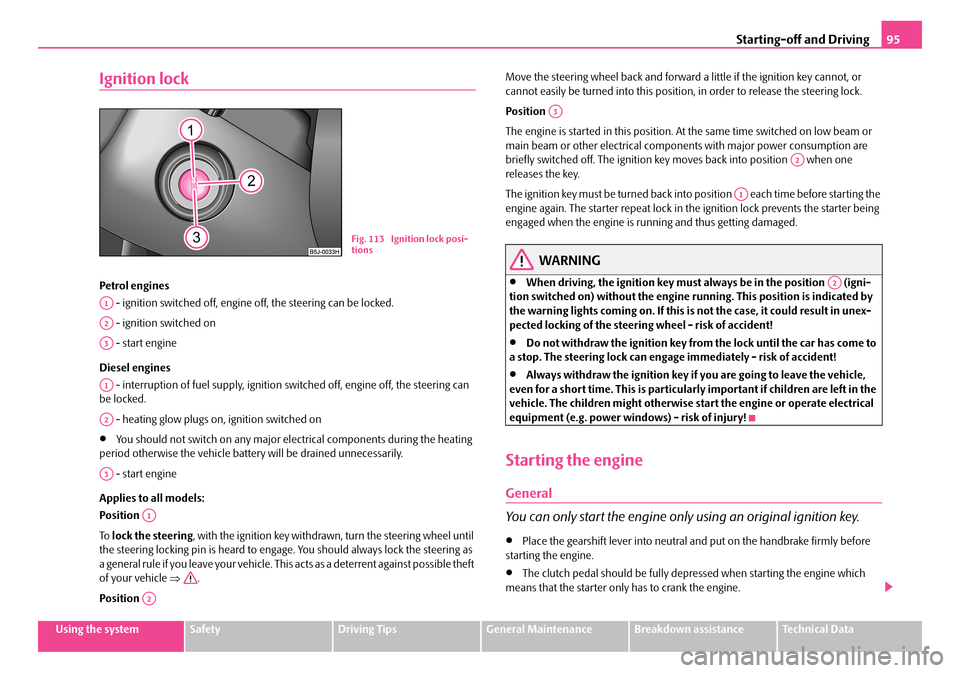
Starting-off and Driving95
Using the systemSafetyDriving TipsGeneral MaintenanceBreakdown assistanceTechnical Data
Ignition lock
Petrol engines
- ignition switched off, engine off, the steering can be locked.
- ignition switched on
- start engine
Diesel engines
- interruption of fuel supply, ignition switched off, engine off, the steering can be locked.
- heating glow plugs on, ignition switched on
•You should not switch on any major electrical components during the heating period otherwise the vehicle battery will be drained unnecessarily.
- start engine
Applies to all models:
Position
To lock the steering, with the ignition key withdrawn, turn the steering wheel until the steering locking pin is heard to engage. You should always lock the steering as a general rule if you leave your vehicle. This acts as a deterrent against possible theft of your vehicle ⇒.
Position
Move the steering wheel back and forward a little if the ignition key cannot, or cannot easily be turned into this position, in order to release the steering lock.
Position
The engine is started in this position. At the same time switched on low beam or main beam or other electrical components with major power consumption are briefly switched off. The ignition key moves back into position when one releases the key.
The ignition key must be turned back into position each time before starting the engine again. The starter repeat lock in the ignition lock prevents the starter being engaged when the engine is running and thus getting damaged.
WARNING
•When driving, the ignition key must always be in the position (igni-tion switched on) without the engine running. This position is indicated by the warning lights coming on. If this is not the case, it could result in unex-pected locking of the steering wheel - risk of accident!
•Do not withdraw the ignition key from the lock until the car has come to a stop. The steering lock can engage immediately - risk of accident!
•Always withdraw the ignition key if you are going to leave the vehicle, even for a short time. This is particularly important if children are left in the vehicle. The children might otherwise start the engine or operate electrical equipment (e.g. power windows) - risk of injury!
Starting the engine
General
You can only start the engine only using an original ignition key.
•Place the gearshift lever into neutral and put on the handbrake firmly before starting the engine.
•The clutch pedal should be fully depressed when starting the engine which means that the starter only has to crank the engine.
Fig. 113 Ignition lock posi-tions
A1
A2
A3
A1
A2
A3
A1
A2
A3
A2
A1
A2
NKO A05F 20.book Page 95 Wednesday, April 2, 2008 1:02 PM
Page 103 of 252
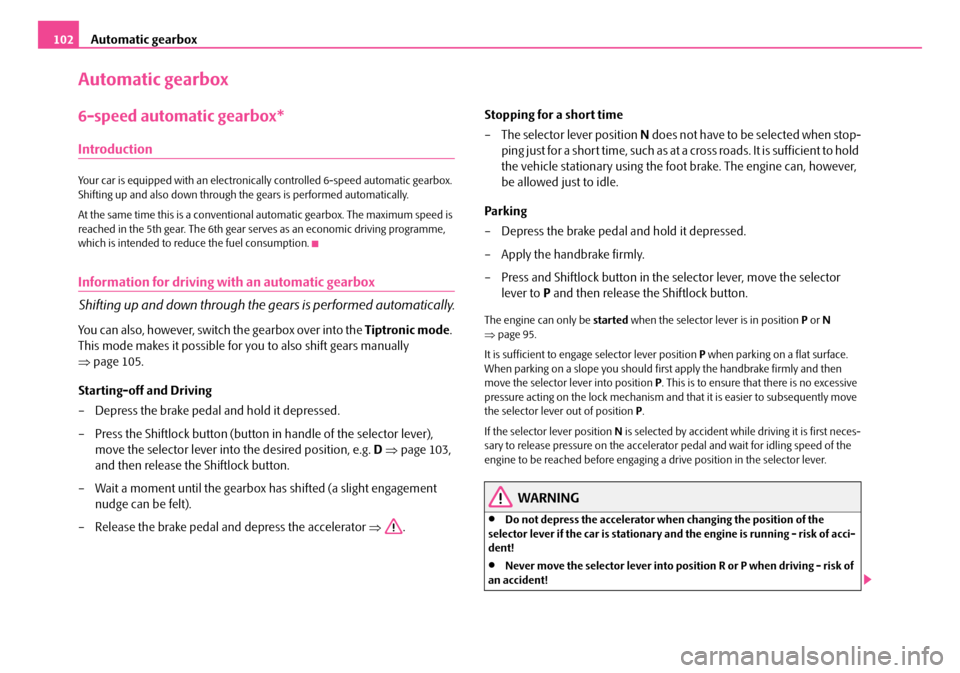
Automatic gearbox102
Automatic gearbox
6-speed automatic gearbox*
Introduction
Your car is equipped with an electronically controlled 6-speed automatic gearbox. Shifting up and also down through the gears is performed automatically.
At the same time this is a conventional automatic gearbox. The maximum speed is reached in the 5th gear. The 6th gear serves as an economic driving programme, which is intended to reduce the fuel consumption.
Information for driving with an automatic gearbox
Shifting up and down through the gears is performed automatically.
You can also, however, switch the gearbox over into the Tiptronic mode.
This mode makes it possible for you to also shift gears manually
⇒page 105.
Starting-off and Driving
– Depress the brake pedal and hold it depressed.
– Press the Shiftlock button (button in handle of the selector lever),
move the selector lever into the desired position, e.g. D ⇒page 103,
and then release the Shiftlock button.
– Wait a moment until the gearbox has shifted (a slight engagement
nudge can be felt).
– Release the brake pedal and depress the accelerator ⇒.
Stopping for a short time
– The selector lever position N does not have to be selected when stop-
ping just for a short time, such as at a cross roads. It is sufficient to hold
the vehicle stationary using the foot brake. The engine can, however,
be allowed just to idle.
Parking
– Depress the brake pedal and hold it depressed.
– Apply the handbrake firmly.
– Press and Shiftlock button in the selector lever, move the selector
lever to P and then release the Shiftlock button.
The engine can only be started when the selector lever is in position P or N ⇒page 95.
It is sufficient to engage selector lever position P when parking on a flat surface. When parking on a slope you should first apply the handbrake firmly and then move the selector lever into position P. This is to ensure that there is no excessive pressure acting on the lock mechanism and that it is easier to subsequently move the selector lever out of position P.
If the selector lever position N is selected by accident while driving it is first neces-sary to release pressure on the accelerator pedal and wait for idling speed of the engine to be reached before engaging a drive position in the selector lever.
WARNING
•Do not depress the accelerator when changing the position of the selector lever if the car is stationary and the engine is running - risk of acci-dent!
•Never move the selector lever into position R or P when driving - risk of an accident!
NKO A05F 20.book Page 102 Wednesday, April 2, 2008 1:02 PM
Page 106 of 252
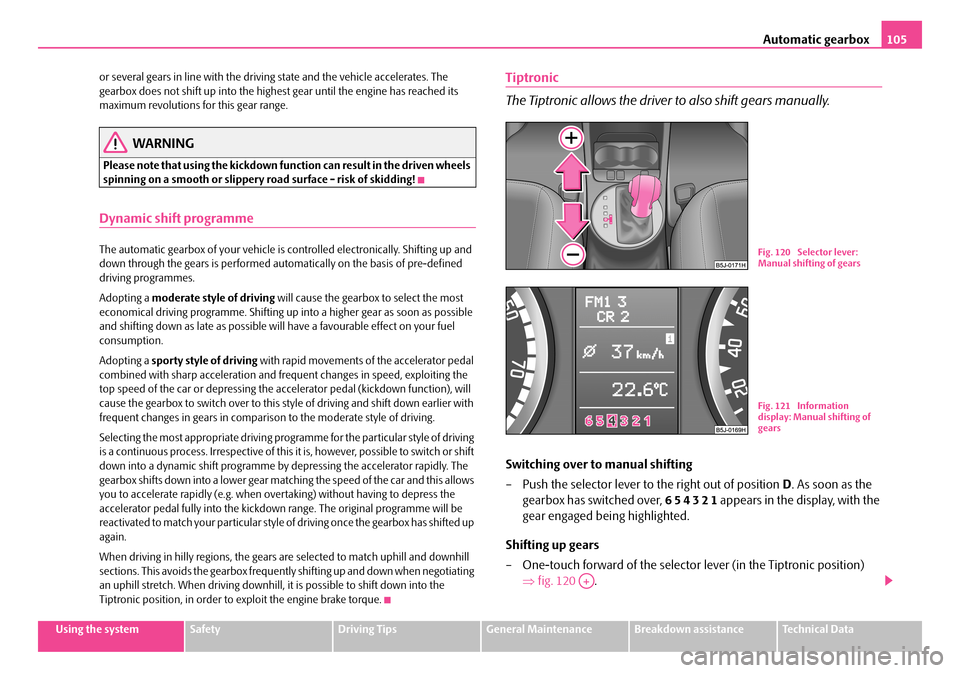
Automatic gearbox105
Using the systemSafetyDriving TipsGeneral MaintenanceBreakdown assistanceTechnical Data
or several gears in line with the driving state and the vehicle accelerates. The gearbox does not shift up into the highest gear until the engine has reached its maximum revolutions for this gear range.
WARNING
Please note that using the kickdown function can result in the driven wheels spinning on a smooth or slippery road surface - risk of skidding!
Dynamic shift programme
The automatic gearbox of your vehicle is controlled electronically. Shifting up and down through the gears is performed automatically on the basis of pre-defined driving programmes.
Adopting a moderate style of driving will cause the gearbox to select the most economical driving programme. Shifting up into a higher gear as soon as possible and shifting down as late as possible will have a favourable effect on your fuel consumption.
Adopting a sporty style of driving with rapid movements of the accelerator pedal combined with sharp acceleration and frequent changes in speed, exploiting the top speed of the car or depressing the accelerator pedal (kickdown function), will cause the gearbox to switch over to this style of driving and shift down earlier with frequent changes in gears in comparison to the moderate style of driving.
Selecting the most appropriate driving programme for the particular style of driving is a continuous process. Irrespective of this it is, however, possible to switch or shift down into a dynamic shift programme by depressing the accelerator rapidly. The gearbox shifts down into a lower gear matching the speed of the car and this allows you to accelerate rapidly (e.g. when overtaking) without having to depress the accelerator pedal fully into the kickdown range. The original programme will be reactivated to match your particular style of driving once the gearbox has shifted up again.
When driving in hilly regions, the gears are selected to match uphill and downhill sections. This avoids the gearbox frequently shifting up and down when negotiating an uphill stretch. When driving downhill, it is possible to shift down into the Tiptronic position, in order to exploit the engine brake torque.
Tiptronic
The Tiptronic allows the driver to also shift gears manually.
Switching over to manual shifting
– Push the selector lever to the right out of position D. As soon as the
gearbox has switched over, 6 5 4 3 2 1 appears in the display, with the
gear engaged being highlighted.
Shifting up gears
– One-touch forward of the selector lever (in the Tiptronic position)
⇒fig. 120 .
Fig. 120 Selector lever: Manual shifting of gears
Fig. 121 Information display: Manual shifting of gears
A+
NKO A05F 20.book Page 105 Wednesday, April 2, 2008 1:02 PM
Page 160 of 252
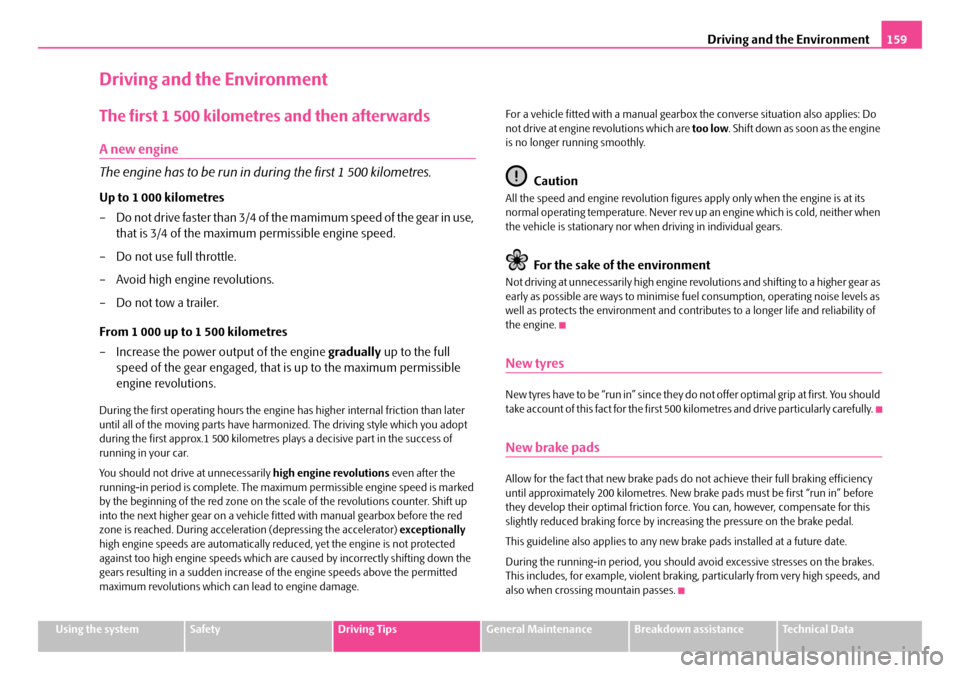
Driving and the Environment159
Using the systemSafetyDriving TipsGeneral MaintenanceBreakdown assistanceTechnical Data
Driving and the Environment
The first 1 500 kilometres and then afterwards
A new engine
The engine has to be run in during the first 1 500 kilometres.
Up to 1 000 kilometres
– Do not drive faster than 3/4 of the mamimum speed of the gear in use,
that is 3/4 of the maximum permissible engine speed.
– Do not use full throttle.
– Avoid high engine revolutions.
– Do not tow a trailer.
From 1 000 up to 1 500 kilometres
– Increase the power output of the engine gradually up to the full
speed of the gear engaged, that is up to the maximum permissible
engine revolutions.
During the first operating hours the engine has higher internal friction than later until all of the moving parts have harmonized. The driving style which you adopt during the first approx.1 500 kilometres plays a decisive part in the success of running in your car.
You should not drive at unnecessarily high engine revolutions even after the running-in period is complete. The maximum permissible engine speed is marked by the beginning of the red zone on the scale of the revolutions counter. Shift up into the next higher gear on a vehicle fitted with manual gearbox before the red zone is reached. During acceleration (depressing the accelerator) exceptionally high engine speeds are automatically reduced, yet the engine is not protected against too high engine speeds which are caused by incorrectly shifting down the gears resulting in a sudden increase of the engine speeds above the permitted maximum revolutions which can lead to engine damage.
For a vehicle fitted with a manual gearbox the converse situation also applies: Do not drive at engine revolutions which are too low. Shift down as soon as the engine is no longer running smoothly.
Caution
All the speed and engine revolution figures apply only when the engine is at its normal operating temperature. Never rev up an engine which is cold, neither when the vehicle is stationary nor when driving in individual gears.
For the sake of the environment
Not driving at unnecessarily high engine revolutions and shifting to a higher gear as early as possible are ways to minimise fuel consumption, operating noise levels as well as protects the environment and contributes to a longer life and reliability of the engine.
New tyres
New tyres have to be “run in” since they do not offer optimal grip at first. You should take account of this fact for the first 500 kilometres and drive particularly carefully.
New brake pads
Allow for the fact that new brake pads do not achieve their full braking efficiency until approximately 200 kilometres. New brake pads must be first “run in” before they develop their optimal friction force. You can, however, compensate for this slightly reduced braking force by increasing the pressure on the brake pedal.
This guideline also applies to any new brake pads installed at a future date.
During the running-in period, you should avoid excessive stresses on the brakes. This includes, for example, violent braking, particularly from very high speeds, and also when crossing mountain passes.
NKO A05F 20.book Page 159 Wednesday, April 2, 2008 1:02 PM
Page 161 of 252
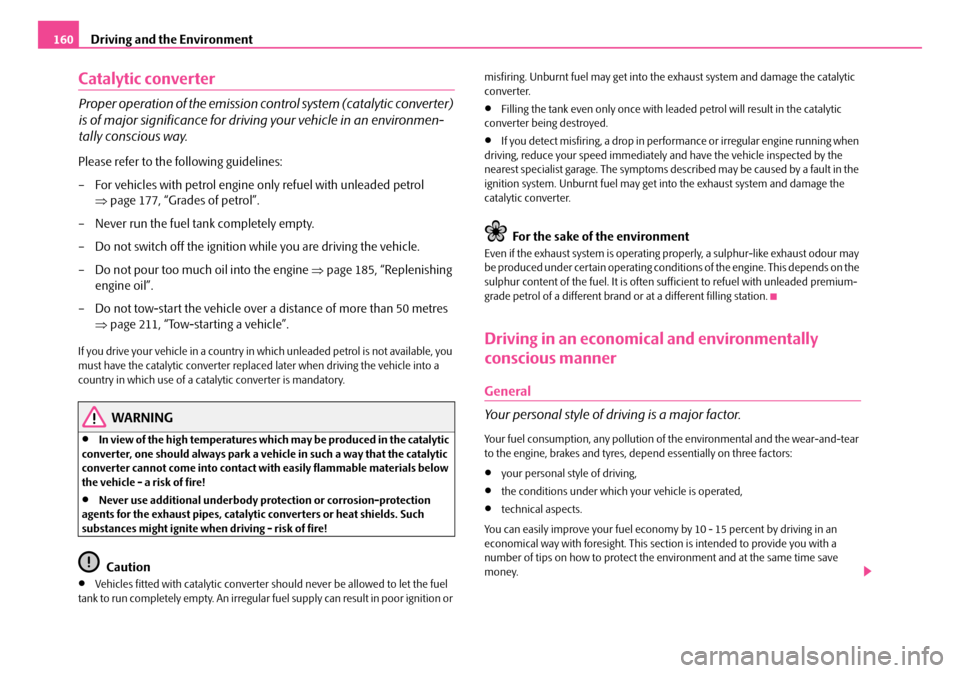
Driving and the Environment160
Catalytic converter
Proper operation of the emission control system (catalytic converter)
is of major significance for driving your vehicle in an environmen-
tally conscious way.
Please refer to the following guidelines:
– For vehicles with petrol engine only refuel with unleaded petrol
⇒page 177, “Grades of petrol”.
– Never run the fuel tank completely empty.
– Do not switch off the ignition while you are driving the vehicle.
– Do not pour too much oil into the engine ⇒page 185, “Replenishing
engine oil”.
– Do not tow-start the vehicle over a distance of more than 50 metres
⇒page 211, “Tow-starting a vehicle”.
If you drive your vehicle in a country in which unleaded petrol is not available, you must have the catalytic converter replaced later when driving the vehicle into a country in which use of a catalytic converter is mandatory.
WARNING
•In view of the high temperatures which may be produced in the catalytic converter, one should always park a vehicle in such a way that the catalytic converter cannot come into contact with easily flammable materials below the vehicle - a risk of fire!
•Never use additional underbody protection or corrosion-protection agents for the exhaust pipes, catalytic converters or heat shields. Such substances might ignite when driving - risk of fire!
Caution
•Vehicles fitted with catalytic converter should never be allowed to let the fuel tank to run completely empty. An irregular fuel supply can result in poor ignition or
misfiring. Unburnt fuel may get into the exhaust system and damage the catalytic converter.
•Filling the tank even only once with leaded petrol will result in the catalytic converter being destroyed.
•If you detect misfiring, a drop in performance or irregular engine running when driving, reduce your speed immediately and have the vehicle inspected by the nearest specialist garage. The symptoms described may be caused by a fault in the ignition system. Unburnt fuel may get into the exhaust system and damage the catalytic converter.
For the sake of the environment
Even if the exhaust system is operating properly, a sulphur-like exhaust odour may be produced under certain operating conditions of the engine. This depends on the sulphur content of the fuel. It is often sufficient to refuel with unleaded premium-grade petrol of a different brand or at a different filling station.
Driving in an economical and environmentally
conscious manner
General
Your personal style of driving is a major factor.
Your fuel consumption, any pollution of the environmental and the wear-and-tear to the engine, brakes and tyres, depend essentially on three factors:
•your personal style of driving,
•the conditions under which your vehicle is operated,
•technical aspects.
You can easily improve your fuel economy by 10 - 15 percent by driving in an economical way with foresight. This section is intended to provide you with a number of tips on how to protect the environment and at the same time save money.
NKO A05F 20.book Page 160 Wednesday, April 2, 2008 1:02 PM
Page 162 of 252

Driving and the Environment161
Using the systemSafetyDriving TipsGeneral MaintenanceBreakdown assistanceTechnical Data
The fuel consumption can naturally also be influenced by factors which are beyond the driver's control. It is, for example, normal for the fuel consumption to increase in winter and under worsened conditions such as poor road conditions, towing a trailer, etc.
The technical requirements for low fuel usage and economic efficiency of the vehicle have already been built into the vehicle at the works. Special attention has been given to minimising negative effects on the environment. It is necessary to take note of the guidelines given in this chapter in order to make best use of these characteristics and to maintain their effectiveness.
Looking ahead when driving
A vehicle's highest fuel consumption occurs it accelerates.
Avoid accelerating and braking unnecessarily. If you drive with forsight you will not need to brake so often and will also then not have to accelerate so much. Let your vehicle coast to a stop, for example, if this is possible, when you see that the next set of traffic lights is at red.
Shifting gears and saving energy
Shifting up early saves on fuel.
Manual gearbox
– Drive no more than about one length of your vehicle in first gear.
Always shift up into the next higher gear at approx. 2 000 to 2 500 revs.
Automatic gearbox
– Depress the accelerator pedal slowly. Do not depress it beyond the
kickdown position, however.
An effective way of achieving good fuel economy is to shift up early. You will consume more fuel if you drive at unnecessarily high revolutions in any given gear.
The ⇒fig. 162 shows the ratio of fuel consumption to the speed of your vehicle in the relevant gears. Fuel consumption in 1st gear is the highest and in 5th gear is the lowest.
Note
•The optimal engine speed should be obtained when accelerating, in order to avoid a high fuel consumption and resonance of the vehicle.
•Also use the information supplied by the multi-functional indicator* ⇒page 13.
Avoiding full throttle
Driving more slowly means saving fuel.
Fig. 162 Fuel consumption in litres/100 km. and speed in km/h.
Fig. 163 Fuel consumption in litres/100 km. and speed in km/h.
NKO A05F 20.book Page 161 Wednesday, April 2, 2008 1:02 PM
Page 163 of 252
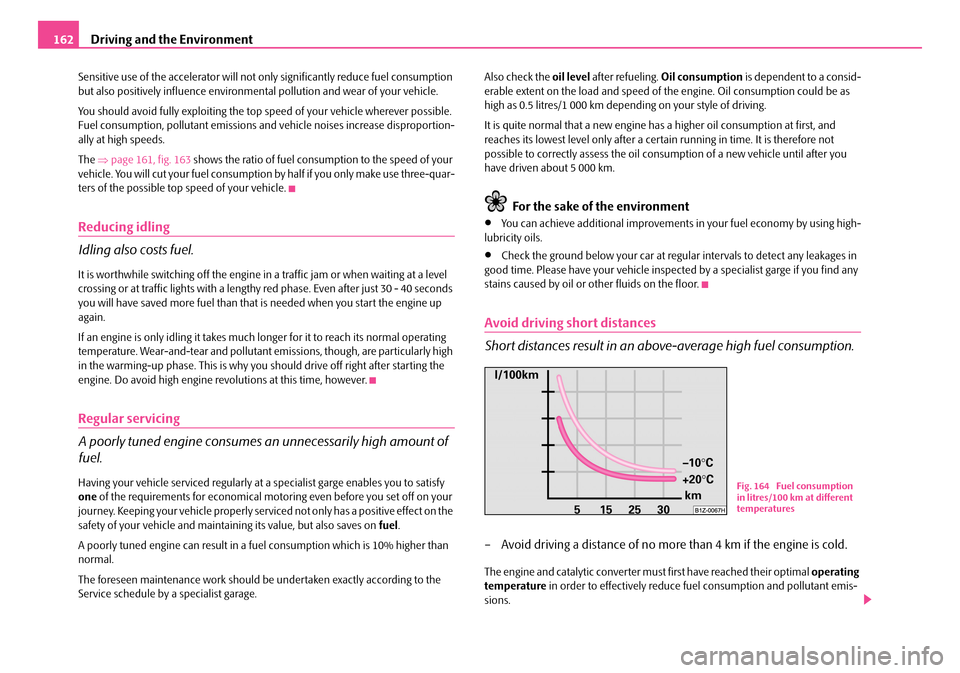
Driving and the Environment162
Sensitive use of the accelerator will not only significantly reduce fuel consumption but also positively influence environmental pollution and wear of your vehicle.
You should avoid fully exploiting the top speed of your vehicle wherever possible. Fuel consumption, pollutant emissions and vehicle noises increase disproportion-ally at high speeds.
The ⇒page 161, fig. 163 shows the ratio of fuel consumption to the speed of your vehicle. You will cut your fuel consumption by half if you only make use three-quar-ters of the possible top speed of your vehicle.
Reducing idling
Idling also costs fuel.
It is worthwhile switching off the engine in a traffic jam or when waiting at a level crossing or at traffic lights with a lengthy red phase. Even after just 30 - 40 seconds you will have saved more fuel than that is needed when you start the engine up again.
If an engine is only idling it takes much longer for it to reach its normal operating temperature. Wear-and-tear and pollutant emissions, though, are particularly high in the warming-up phase. This is why you should drive off right after starting the engine. Do avoid high engine revolutions at this time, however.
Regular servicing
A poorly tuned engine consumes an unnecessarily high amount of
fuel.
Having your vehicle serviced regularly at a specialist garge enables you to satisfy one of the requirements for economical motoring even before you set off on your journey. Keeping your vehicle properly serviced not only has a positive effect on the safety of your vehicle and maintaining its value, but also saves on fuel.
A poorly tuned engine can result in a fuel consumption which is 10% higher than normal.
The foreseen maintenance work should be undertaken exactly according to the Service schedule by a specialist garage.
Also check the oil level after refueling. Oil consumption is dependent to a consid-erable extent on the load and speed of the engine. Oil consumption could be as high as 0.5 litres/1 000 km depending on your style of driving.
It is quite normal that a new engine has a higher oil consumption at first, and reaches its lowest level only after a certain running in time. It is therefore not possible to correctly assess the oil consumption of a new vehicle until after you have driven about 5 000 km.
For the sake of the environment
•You can achieve additional improvements in your fuel economy by using high-lubricity oils.
•Check the ground below your car at regular intervals to detect any leakages in good time. Please have your vehicle inspected by a specialist garge if you find any stains caused by oil or other fluids on the floor.
Avoid driving short distances
Short distances result in an above-average high fuel consumption.
– Avoid driving a distance of no more than 4 km if the engine is cold.
The engine and catalytic converter must first have reached their optimal operating temperature in order to effectively reduce fuel consumption and pollutant emis-sions.
Fig. 164 Fuel consumption in litres/100 km at different temperatures
NKO A05F 20.book Page 162 Wednesday, April 2, 2008 1:02 PM
Page 164 of 252
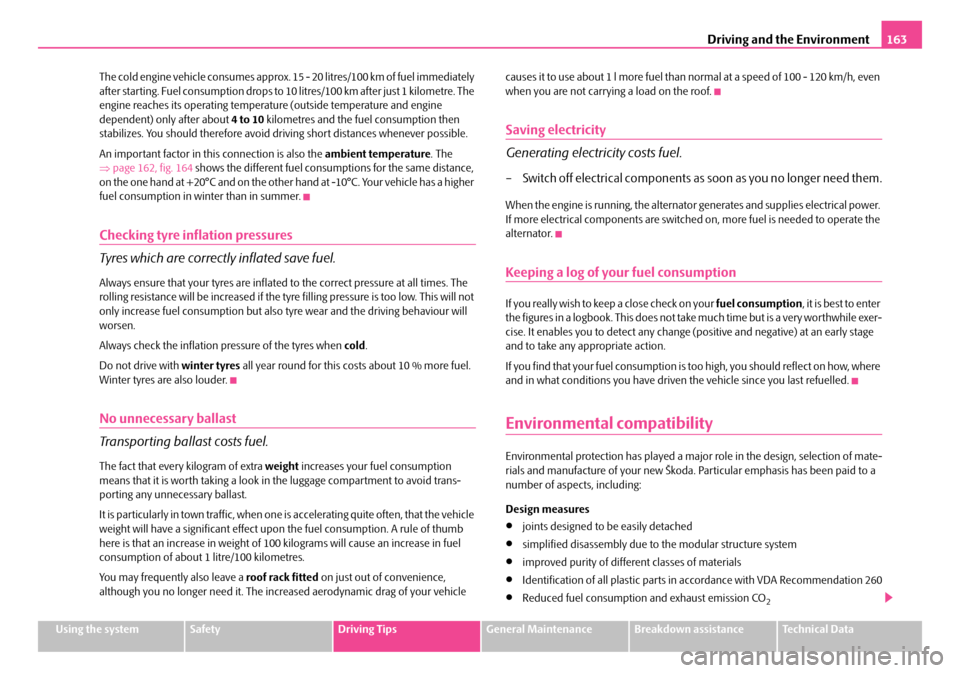
Driving and the Environment163
Using the systemSafetyDriving TipsGeneral MaintenanceBreakdown assistanceTechnical Data
The cold engine vehicle consumes approx. 15 - 20 litres/100 km of fuel immediately after starting. Fuel consumption drops to 10 litres/100 km after just 1 kilometre. The engine reaches its operating temperature (outside temperature and engine dependent) only after about 4 to 10 kilometres and the fuel consumption then stabilizes. You should therefore avoid driving short distances whenever possible.
An important factor in this connection is also the ambient temperature. The ⇒page 162, fig. 164 shows the different fuel consumptions for the same distance, on the one hand at +20°C and on the other hand at -10°C. Your vehicle has a higher fuel consumption in winter than in summer.
Checking tyre inflation pressures
Tyres which are correctly inflated save fuel.
Always ensure that your tyres are inflated to the correct pressure at all times. The rolling resistance will be increased if the tyre filling pressure is too low. This will not only increase fuel consumption but also tyre wear and the driving behaviour will worsen.
Always check the inflation pressure of the tyres when cold.
Do not drive with winter tyres all year round for this costs about 10 % more fuel. Winter tyres are also louder.
No unnecessary ballast
Transporting ballast costs fuel.
The fact that every kilogram of extra weight increases your fuel consumption means that it is worth taking a look in the luggage compartment to avoid trans-porting any unnecessary ballast.
It is par ticularly i n town tra ffi c, whe n one is accelerating quite often, that the vehicle weight will have a significant effect upon the fuel consumption. A rule of thumb here is that an increase in weight of 100 kilograms will cause an increase in fuel consumption of about 1 litre/100 kilometres.
You may frequently also leave a roof rack fitted on just out of convenience, although you no longer need it. The increased aerodynamic drag of your vehicle
causes it to use about 1 l more fuel than normal at a speed of 100 - 120 km/h, even when you are not carrying a load on the roof.
Saving electricity
Generating electricity costs fuel.
– Switch off electrical components as soon as you no longer need them.
When the engine is running, the alternator generates and supplies electrical power. If more electrical components are switched on, more fuel is needed to operate the alternator.
Keeping a log of your fuel consumption
If you really wish to keep a close check on your fuel consumption, it is best to enter the figures in a logbook. This does not take much time but is a very worthwhile exer-cise. It enables you to detect any change (positive and negative) at an early stage and to take any appropriate action.
If you find that your fuel consumption is too high, you should reflect on how, where and in what conditions you have driven the vehicle since you last refuelled.
Environmental compatibility
Environmental protection has played a major role in the design, selection of mate-rials and manufacture of your new Škoda. Particular emphasis has been paid to a number of aspects, including:
Design measures
•joints designed to be easily detached
•simplified disassembly due to the modular structure system
•improved purity of different classes of materials
•Identification of all plastic parts in accordance with VDA Recommendation 260
•Reduced fuel consumption and exhaust emission CO2
NKO A05F 20.book Page 163 Wednesday, April 2, 2008 1:02 PM
Page 178 of 252
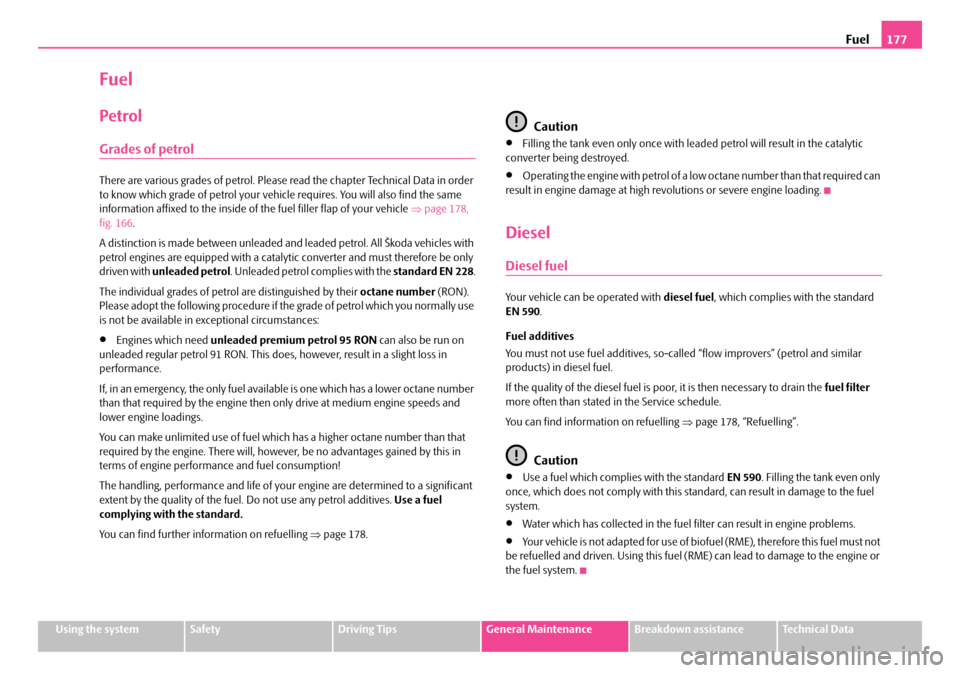
Fuel177
Using the systemSafetyDriving TipsGeneral MaintenanceBreakdown assistanceTechnical Data
Fuel
Petrol
Grades of petrol
There are various grades of petrol. Please read the chapter Technical Data in order to know which grade of petrol your vehicle requires. You will also find the same information affixed to the inside of the fuel filler flap of your vehicle ⇒page 178, fig. 166.
A distinction is made between unleaded and leaded petrol. All Škoda vehicles with petrol engines are equipped with a catalytic converter and must therefore be only driven with unleaded petrol. Unleaded petrol complies with the standard EN 228.
The individual grades of petrol are distinguished by their octane number (RON). Please adopt the following procedure if the grade of petrol which you normally use is not be available in exceptional circumstances:
•Engines which need unleaded premium petrol 95 RON can also be run on unleaded regular petrol 91 RON. This does, however, result in a slight loss in performance.
If, in an emergency, the only fuel available is one which has a lower octane number than that required by the engine then only drive at medium engine speeds and lower engine loadings.
You can make unlimited use of fuel which has a higher octane number than that required by the engine. There will, however, be no advantages gained by this in terms of engine performance and fuel consumption!
The handling, performance and life of your engine are determined to a significant extent by the quality of the fuel. Do not use any petrol additives. Use a fuel complying with the standard.
You can find further information on refuelling ⇒page 178.
Caution
•Filling the tank even only once with leaded petrol will result in the catalytic converter being destroyed.
•Operating the engine with petrol of a low octane number than that required can result in engine damage at high revolutions or severe engine loading.
Diesel
Diesel fuel
Your vehicle can be operated with diesel fuel, which complies with the standard EN 590.
Fuel additives
You must not use fuel additives, so-called “flow improvers” (petrol and similar products) in diesel fuel.
If the quality of the diesel fuel is poor, it is then necessary to drain the fuel filter more often than stated in the Service schedule.
You can find information on refuelling ⇒page 178, “Refuelling”.
Caution
•Use a fuel which complies with the standard EN 590. Filling the tank even only once, which does not comply with this standard, can result in damage to the fuel system.
•Water which has collected in the fuel filter can result in engine problems.
•Your vehicle is not adapted for use of biofuel (RME), therefore this fuel must not be refuelled and driven. Using this fuel (RME) can lead to damage to the engine or the fuel system.
NKO A05F 20.book Page 177 Wednesday, April 2, 2008 1:02 PM
Page 185 of 252
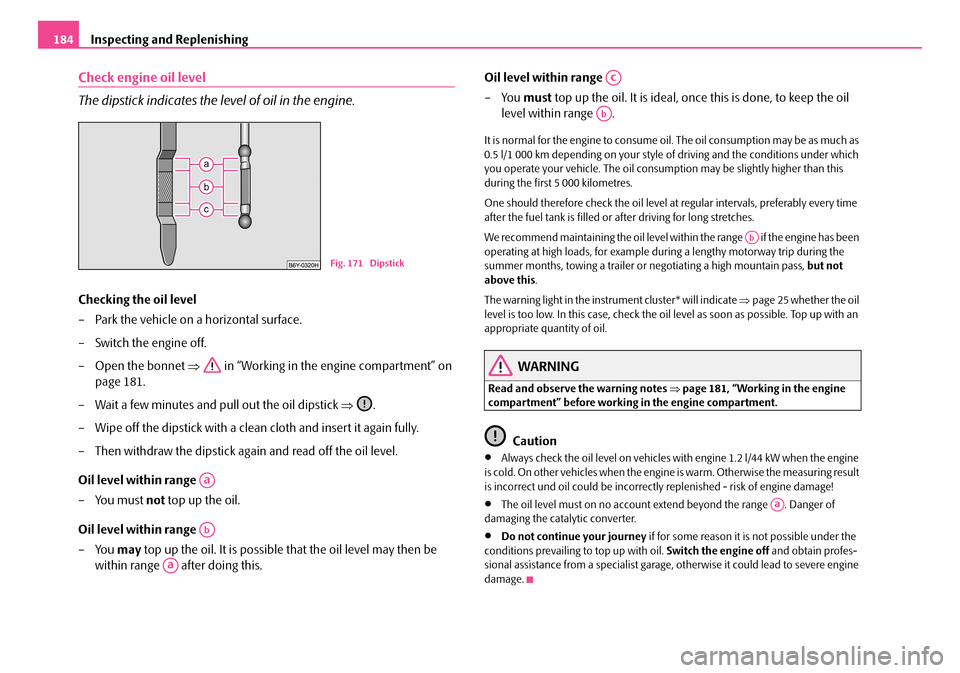
Inspecting and Replenishing184
Check engine oil level
The dipstick indicates the level of oil in the engine.
Checking the oil level
– Park the vehicle on a horizontal surface.
– Switch the engine off.
– Open the bonnet ⇒ in “Working in the engine compartment” on
page 181.
– Wait a few minutes and pull out the oil dipstick ⇒.
– Wipe off the dipstick with a clean cloth and insert it again fully.
– Then withdraw the dipstick again and read off the oil level.
Oil level within range
–You must not top up the oil.
Oil level within range
–You may top up the oil. It is possible that the oil level may then be
within range after doing this.
Oil level within range
– You must top up the oil. It is ideal, once this is done, to keep the oil
level within range .
It is normal for the engine to consume oil. The oil consumption may be as much as 0.5 l/1 000 km depending on your style of driving and the conditions under which you operate your vehicle. The oil consumption may be slightly higher than this during the first 5 000 kilometres.
One should therefore check the oil level at regular intervals, preferably every time after the fuel tank is filled or after driving for long stretches.
We recommend maintaining the oil level within the range if the engine has been operating at high loads, for example during a lengthy motorway trip during the summer months, towing a trailer or negotiating a high mountain pass, but not above this.
The warning light in the instrument cluster* will indicate ⇒page 25 whether the oil level is too low. In this case, check the oil level as soon as possible. Top up with an appropriate quantity of oil.
WARNING
Read and observe the warning notes ⇒page 181, “Working in the engine compartment” before working in the engine compartment.
Caution
•Always check the oil level on vehicles with engine 1.2 l/44 kW when the engine is cold. On other vehicles when the engine is warm. Otherwise the measuring result is incorrect und oil could be incorrectly replenished - risk of engine damage!
•The oil level must on no account extend beyond the range . Danger of damaging the catalytic converter.
•Do not continue your journey if for some reason it is not possible under the conditions prevailing to top up with oil. Switch the engine off and obtain profes-sional assistance from a specialist garage, otherwise it could lead to severe engine damage.
Fig. 171 Dipstick
Aa
Ab
Aa
Ac
Ab
Ab
Aa
NKO A05F 20.book Page 184 Wednesday, April 2, 2008 1:02 PM